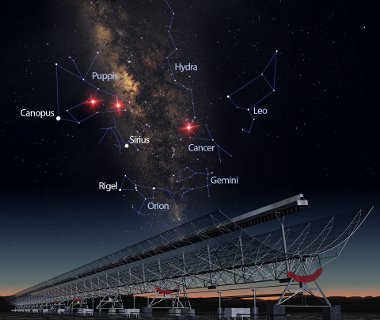Alien spacecraft or merging black holes? Powerful radio bursts are from outer space, say scientists

Researchers have finally been able to confirm that the baffling ‘fast radio bursts’, which are about 1 billion times brighter than anything in our galaxy, have their origin in outer space.
The mysterious phenomena were first noticed in 2007 when the ‘Lorimer burst’ was discovered in archived data from 2001. Since then, more than a dozen fast radio bursts (FRBs) have been detected in telescope data.
The blasts last for just a few milliseconds, occurring as one-off events with just a single burst recorded from a single location. They can emit as much power as 500 million suns.
There’s still no generally accepted explanation for the strange astrophysical phenomena. One theory is that they are caused by the collision of very dense objects such as merging black holes or neutron stars.
A recent study even went as far as proposing that they might be coming from giant planet-sized transmitters in galaxies billions of light-years away. In that case the researchers speculated that could be used for powering ‘solar sails’ on a colossal alien spacecraft.
One potential explanation of the mystery, which would have been a major let down, was that the FRB’s weren’t even coming from outer space, but rather were some form of local interference which was tricking astronomers.
Scientists have had a hard time pinning down the exact origin of the bursts because of limitations in the satellites that can find them. “Conventional single dish radio telescopes have difficulty establishing that transmissions originate beyond the Earth’s atmosphere,” one of the researchers responsible for the breakthrough, Dr Chris Flynn from Swinburne University of Technology in Australia, explains.
In 2013 researchers figured out that the giant Molonglo telescope in Australia was ideal for identifying and tracking the origin of FRBs due to its 18,000 sq meter (194,000 sq ft) collecting area and its large field of view. The way the telescope is built also means that it is not capable of picking up signals from within Earth’s atmosphere, ruling out the possibility of local interference.
The team then began the mammoth task of poring through all of the telescope’s data. As Molonglo produces more than 1000 terabytes of data every single day this was no mean feat.
They were rewarded for their efforts, however, with the discovery of three FRBs and, as Molonglo doesn’t pick up local interference, they could confirm that the mysterious signals were coming from outer space.
“It is very exciting to see the University of Sydney’s Molonglo telescope making such important scientific discoveries by partnering with Swinburne’s expertise in supercomputing”, another researcher, Professor Anne Green of the University of Sydney, said.
“Figuring out where the bursts come from is the key to understanding what makes them. Only one burst has been linked to a specific galaxy,”said lead researcher Manisha Caleb. “We expect Molonglo will do this for many more bursts.”
The study adds weight to findings from earlier this year which claimed the source of a FRB was a tiny dwarf galaxy more than 3 billion light-years from Earth.
The Molonglo telescope is now being modified in order to help it provide even further insight into the FRBs. It’s even hoped it may be able to pinpoint specific galactic origins of the radio blasts.
A paper on the discovery, titled ‘The first interferometric detections of Fast Radio Bursts’, has been accepted for publication in Monthly Notices of the Royal Astronomical Society.






Nenhum comentário:
Postar um comentário